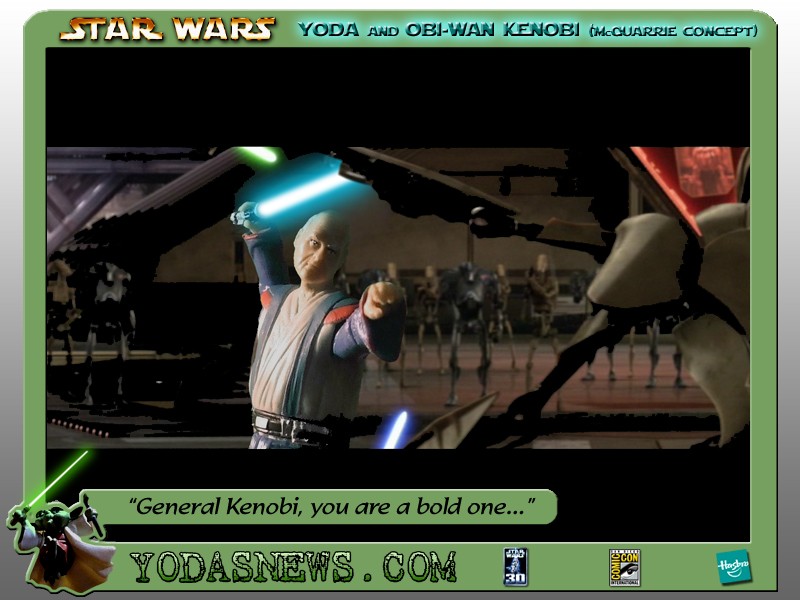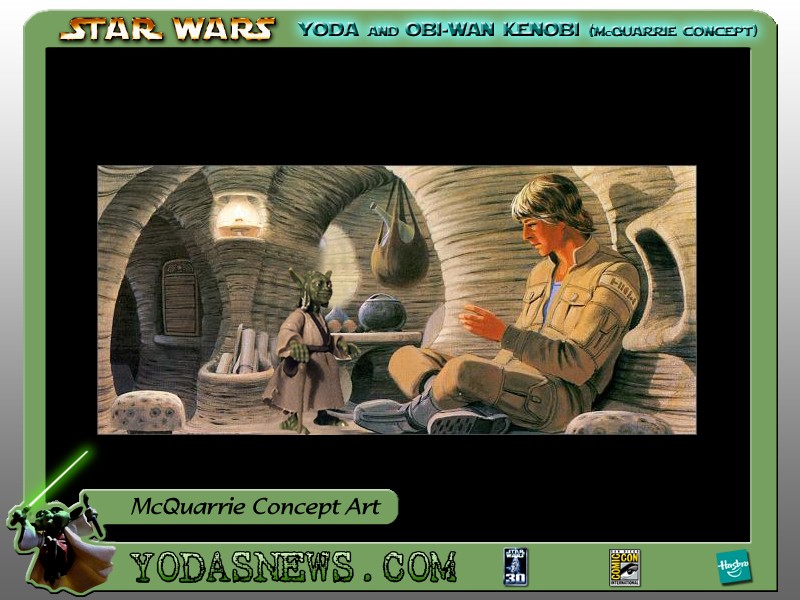Yodasnews Review: McQuarrie Concept Yoda and Obi-Wan Kenobi
San Diego Comic Con 2007 Exclusive
Review and Photography by Jeffrey A. Gouse (SithLord0498)
Review Date: September 19, 2007
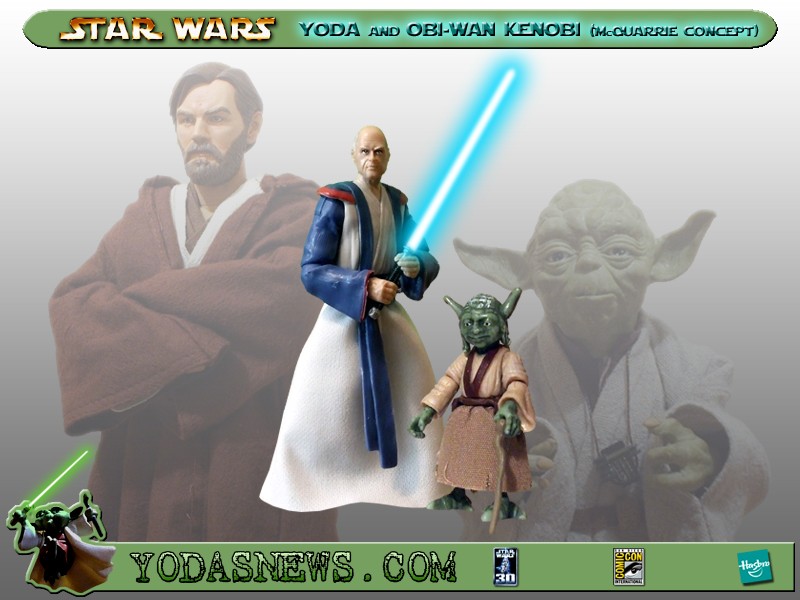
FIGURE SPECIFICATIONS
In what has been widely considered an unfair move by Hasbro, yet another entry in the collector-favorite McQuarrie Concept Signature Series was released as a convention exclusive, and, like the Celebration 4 exclusive C-3PO and R2-D2 combo before them, Yoda and Obi-Wan Kenobi came packaged as a set. To the relief of many, this set heralded the end of the convention exclusives in the McQuarrie line. Oddly enough though, it has been easier to secure these exclusive figures than the entries shipping directly to retail shelves. At least it has been for this reviewer.
The Yoda/Kenobi set also marked the end of another unpopular era for the McQuarrie figures—the double digit pricing tier. True, the recently released Concept Grievous bears a $16.99 tag, but it is a separate entity from the official McQuarrie Signature Series. Considering this particular set retailed for $14.99, we will find an answer to this question: Is this set worth the price?
PORTRAIT (Yoda) – Below Average
The only thing keeping this portrait afloat is its highly whimsical expression for which the wide eyes and carefully curved smile are the cornerstones. This portrait perfectly encapsulates the initially playful demeanor of the Jedi Master when an unsuspecting Luke first meets him.
But for as humorous as the portrait may be, it is NOT the McQuarrie Concept Yoda presented on the card. Granted, there were several other renditions of Yoda at the concept level, but in no way do they resemble this figure. It looks as if Hasbro took the featured art and both idealized and de-aged it. The pictured Yoda is an ancient, heavily wrinkled, emaciated, troll-like creature with flowing white hair, an oversized head, and eyes sparkling with wisdom.
What Hasbro gave us is a younger and more proportioned version of Yoda if he were down in Fraggle Rock or hanging tough with the Muppets.
The wrinkles are still intricately sculpted and detailed, but they are far fewer—especially around the mouth. The concept art shows an amount of wrinkles so massive that the skin looks like a sun-baked and shriveled raisin. On the figure, there are hardly any wrinkles, and the cheeks are curiously plump. The flowing hair has been replaced by three chunks of plastic sculpted in a general resemblance to the orientation and placement of the hair in the drawing, and the white paint has been carelessly and quickly dry brushed onto the plastic. There is no consistency, and less than half of the required area is white.
To pass this off as a plastic rendition of the concept art is an insult to Ralph McQuarrie—especially in light of the superior sculpting done on other figures in the series.
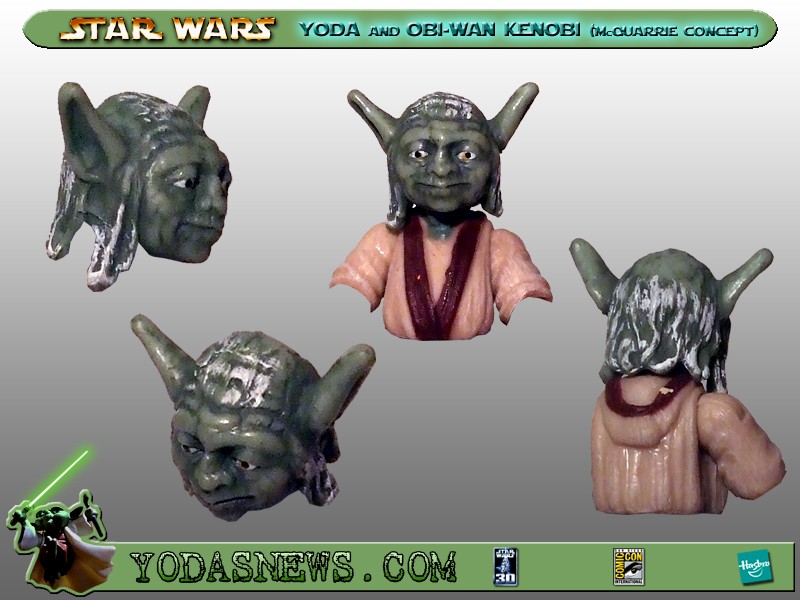
PORTRAIT (Obi-Wan Kenobi) – Above Average
This is a very difficult element to evaluate because the extent of available source material is the semi-transparent grayscale concept art used on the front of the card. There is no pictorial material to be found in either From Star Wars to Indiana Jones: Best of the Lucasfilm Archives or the recently released “ultimate” McQuarrie compendium, The Art of Ralph McQuarrie from Dreams and Visions Press. Both Yahoo! and Google searches turned up empty for Kenobi concept art circa mid-1970s, and McQuarrie’s official website yielded nothing as well. With my available sources of reference material depleted, the critique of this portrait is going to have to stand more on its own aesthetic merits and less on accuracy to a source.
That being said, the Obi-Wan portrait is a very symmetrical piece with many crisp and clear-cut facial creases and wrinkles. The brow is the slightest bit furrowed to correspond with the determined demeanor seen in the sculpting of the eyes. The hair (what little there is) follows a sloping contour from the ears and mid-cranium down to the neck with faint but uniform lines etched into the plastic, simulating the hair’s texture.
Unfortunately, the hair is also the location of the portrait’s biggest sculpting flaw. On the right hand side (from the figure’s POV), there are two splotches and a straight line scratch in the plastic. These are clearly factory errors, but they nevertheless mar the overall aesthetic integrity of the piece. Another glitch in the sculpt—albeit an exceedingly minor one—is a softness in the crease along the right hand side of this sample’s face, which disrupts the near perfect symmetry.
As for the paint applications, they are exceptionally clean, which is to be expected given their minimal use. More complex applications naturally run the risk of more errors. The edging on the hairline is very crisp with no bleeding. Closer examination reveals, however, a few areas where the hair sculpting is uneven and extends beyond the paint boundaries. Presumably, the intention was to produce a more realistic recessive hairline. The quality of the paint applications necessary to execute that idea, though, would be highly prone to error, and Hasbro took the more sensible approach in terms of consistency and quality control. The eyes sport a fairly lifelike application although the eye on the figure’s left hand side is a little bit lazy.
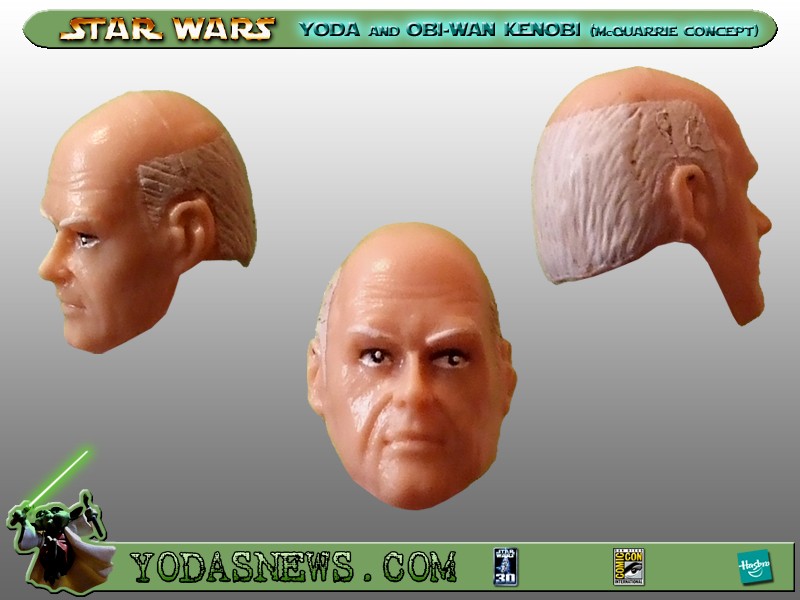
COSTUME (Yoda) – Below Average
Sad to say, the realization of the concept clothing is not that much more accurate than the portrait. The basic design (and I do mean “basic”) is pretty accurate, and the fraying on the soft goods skirt is passable. Unfortunately, that is where the positives end. The skirt falls too long on the figure and covers too much of the legs while the sculpted sleeves fail to fall far enough. In fact, the skirt should not even be a skirt since the concept art clearly shows a robe tied shut by the belt—not a Marilyn Monroe wardrobe reject. The color is also too light when compared to the concept art, and the belt is too thick.
Portrait and costume combined, this Yoda looks neat, but it is certainly not a faithful McQuarrie Concept Yoda.
COSTUME (Obi-Wan Kenobi) – Above Average
The same caveat concerning a lack of reference material applies to the costume as well, and this evaluation of the costume rests again on its own aesthetic and functional merits.
What immediately struck me about the costume are McQuarrie’s heavy Oriental influences. Of course, this makes complete sense given George Lucas’ inspiration from the Akira Kurosawa film The Hidden Fortress. Note, however, that the Oriental flavoring of Kenobi’s attire leans more toward the religious dressings of a priest. This clearly places the emphasis on Obi-Wan’s relationship with the “mystical” Force as opposed to his history as a great warrior in the Clone Wars, and it matches up with the grandfatherly mentor role Kenobi played in Episode IV.
The best elements of the costume are the soft goods skirt and the belt (not to be confused with the separate sash placed below it). In what appears to be Hasbro’s new stock white fabric, the durable material seen in the VTSC Snowtrooper makes a return appearance. Fraying around the un-hemmed edges is minimal, and the fabric has a heavy yet malleable hang. The belt is noteworthy for the following reasons: details, paint applications, and its functional lightsaber clip. Besides that clip, there are several sculpted attachments on the belt which include a flat metal buckle, two metal plates with small rivets, and two utility pouches. All of them are realistically sculpted, and paint runs are few. The lightsaber clip is simple yet functions exceptionally well, holding the hilt snugly in place.
Sporting realistic wrinkles and folds, the sleeves are sculpted with a naturalistic hang at the cuffs. The same well-simulated appearance holds true for the sash “wrapped” around Kenobi’s hips below the utility belt. The knot’s sculpting looks sufficiently layered, and two long pieces of excess “fabric” drape down near the ankles, the longer piece overlapping the other. Subtle crease lines are etched onto the strips as well, increasing the realism found in the piece.
Effectively executed realism is a consistent element found in the sculpting of this figure because even the pants have lifelike creases as well as billow outward at the point where real cloth would do the same from being bunched up and tucked into the boots. However, the boots are where this figure runs into a problem with the paint applications. There are several paint runs near the soles and distorted lines where they should be straight.
Another area on the costume that suffers from sloppy paint application is along the boundary between the predominant bluish purple paint and the wine-colored band on the shoulder pads. This is both surprising and a disappointment considering the simplicity of it. However, that is the extent to which the paint is sloppy, and the remainder of the upper torso is cleanly painted.
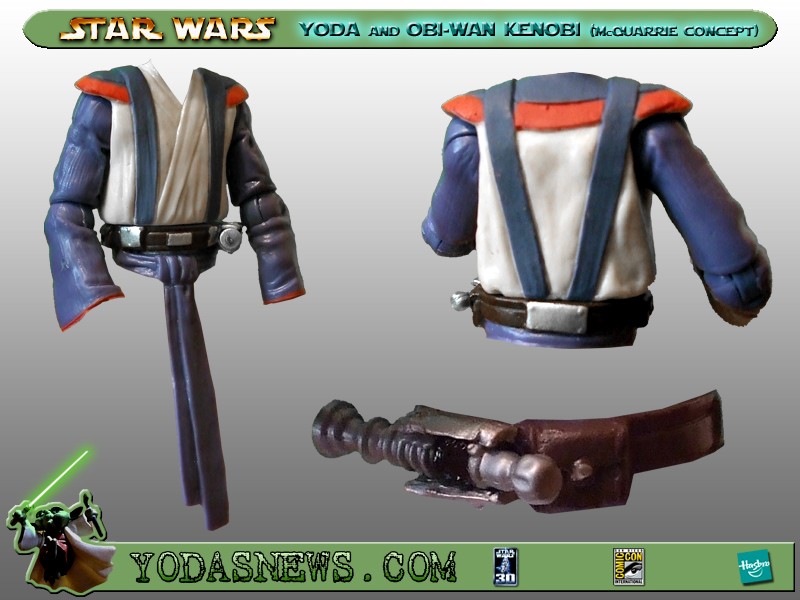
ARTICULATION / DESIGN STABILITY (Yoda) – Average (Bordering on “Below Average”)
Yoda’s articulation is not as impressive as one would hope. To start, the length of his arms combined with the bulkier nature of his sleeves hinders the effectiveness of the ball-jointed elbows. However, it isn’t too detrimental since this version of Yoda wasn’t meant for lightsaber combat. In the late ‘70s, Yoda was more of a contemplative pacifist than a hyperkinetic warrior. That trait wouldn’t see reality until 2002.
While there is good downward range of motion, the sculpted hair severely restricts the figure’s ability to tilt its head upward—at least not without exposing a large and unsightly ball joint before falling right off the body. This is a major flaw because Yoda is unable to establish an eye line with any humanoid characters unless positioned on an elevated surface.
Ankle and knee articulation are missing as well. It would be safe to say that the rationale here was that the legs are too thin for joints, but it could be done. The only loss would be the sculpting detail on the legs, but they are incorrectly covered up by the soft goods anyway. At least this way, the error would’ve served a positive function. But even worse, the omission of these joints negatively impacts the stability of the figure because its current center of gravity is misaligned, resulting in falling over unless unnaturally hunched over or attached to a figure stand.
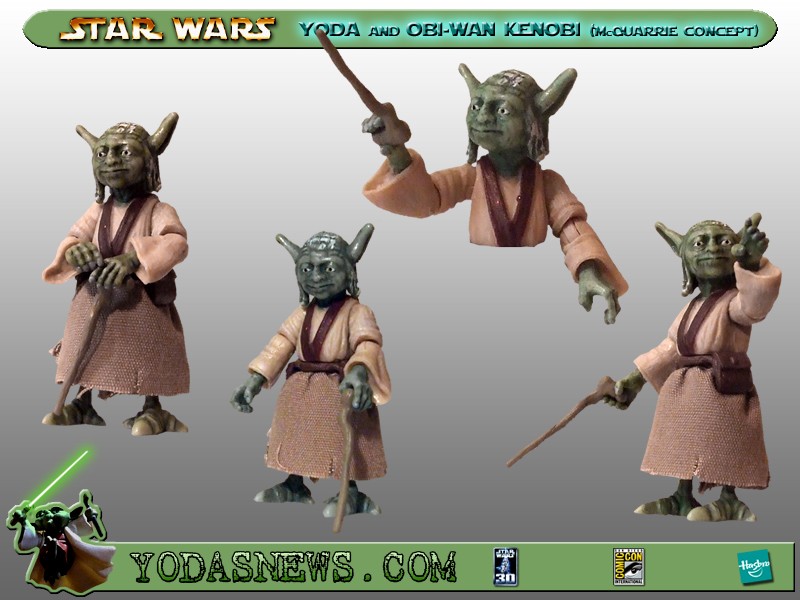
ARTICULATION / DESIGN STABILITY (Obi-Wan Kenobi) – Average (Bordering on “Below Average”)
In a nutshell, everything from the waist up is great, and most elements below the waist are a frustrating disappointment. The most negative aspect with the articulation is the complete lack of knee articulation, which severely restricts the amount of fighting stances possible with this figure. The ball-jointed ankles allow for some flexibility in the lower body’s poseability, but it is very little help. Much like with Yoda, eliminating the knee articulation means put it on a stand, hunch it over unnaturally, or deal with it falling over at the slightest vibration.
The upper body articulation is as good as can be expected with an abundance of ball joints—five in all. The incorporation of such joints in the arms allows for a variety of lightsaber combat and gestural poses, and the ball-jointed head provides a wide range of motion. The swivel wrists and waist are unremarkable on their own, but they complete the formula for well-rounded upper body articulation.
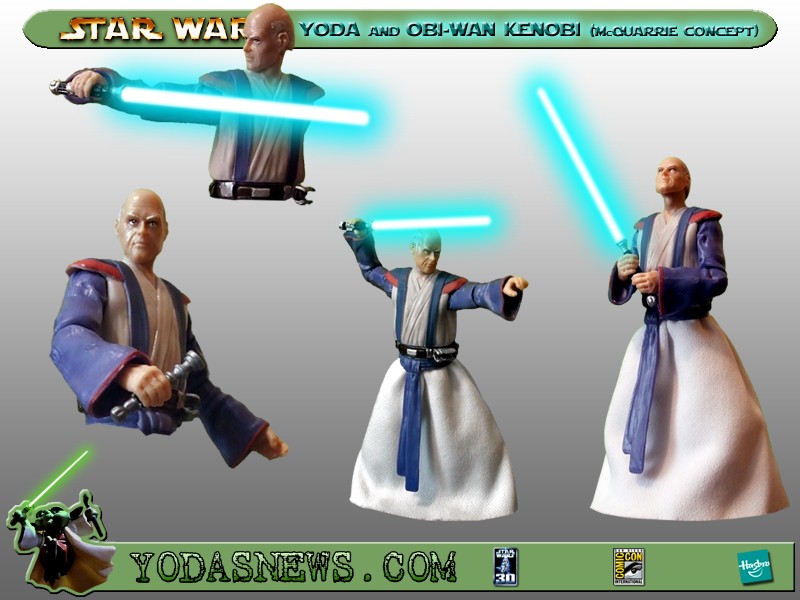
WALKING CANE (Yoda) – Excellent
The lone accessory for Yoda, the walking cane, is very close to the eventual screen prop, something that did not happen very often with Original Trilogy concept art. The most notable differences are the greenish gray color and more pronounced handle on the concept cane. It is sculpted to snugly fit in either hand without the additional support of the notorious clear rubber band, and it is lightweight enough to be placed in a droid whacking pose without falling out of Yoda’s hand.
LIGHTSABERS (Obi-Wan Kenobi) – Poor
Yes, Hasbro included two lightsabers. Yes, there’s an ignited and unignited version. Yes, both are detailed, and the ignited hilt adheres closely to the source material. So why the sub par rating?
Because not only are the hilts recycled from previous movie figures, they are also two different versions: Revenge of the Sith (ignited) and A New Hope (unignited). While the reference material is lacking, it is reasonable to assume that the concept saber for Obi-Wan differs from both and would warrant either a brand new sculpt or a modified version of one of the two sabers. Recycling old sabers exactly as-is demonstrates a laziness which is inexcusable for such a highly-priced set.
And using two completely different hilts??
Still don’t know what to say about that.
“FUN FACTOR” (Yoda) – Average (Bordering on “Below Average”)
Yoda, despite the upper body articulation, is little more than a display piece. Most of the Imperial-era mannerisms associated with the character depend heavily on Yoda’s head having the fullest range of motion possible. Of course, this makes sense since the original Yoda puppet was stationary and had to emote as much as possible through upper body movements. With this figure, that range of motion simply isn’t there because of the stiff hair. Furthermore, the lack of stability results in frequently toppling over unless secured to the shelf through some means (figure stand, wacky-tack, etc.).
“FUN FACTOR” (Obi-Wan Kenobi) –Average (Bordering on “Above Average”)
Despite the limited lower body articulation, there are enough posing possibilities to give collectors a decent array of display options. Just make sure you use a figure stand. Additionally, Obi-Wan can be posed with all the McQuarrie concept figures to date to create concept dioramas of scenes from the Original Trilogy—Boba Fett being the only exception. The Oriental accents also add a touch of Old World variety to the McQuarrie display.
OVERALL RATING: (Yoda) – Below Average (Bordering on “Average”); (Obi-Wan Kenobi) – Average
In the final analysis, only Kenobi reaches average status. When compared to certain other McQuarrie figures such as Boba Fett and C-3PO, the ratings slide toward the lower end of the spectrum. While that may seem excessively critical, these ratings also take into account the $15 plus shipping price tag for this set. At $8-10 and with retail store availability, the shortcomings would be much easier to forgive—although the erroneous Yoda portrait is inexcusable at any price.
The value just isn’t there to justify the cost, and this set is only a worthwhile purchase for McQuarrie completists. Even focus collectors may be hard-pressed to drop this kind of change for their particular character—unless of course they have a Jedi or Yoda/Kenobi focus.
Avoid paying anything above retail for these figures. If possible (and cheaper), try to score them loose on eBay or through forum community Classified sections. Word on the digital street is that the Yodasnews forum has a lot of real stand-up members.
